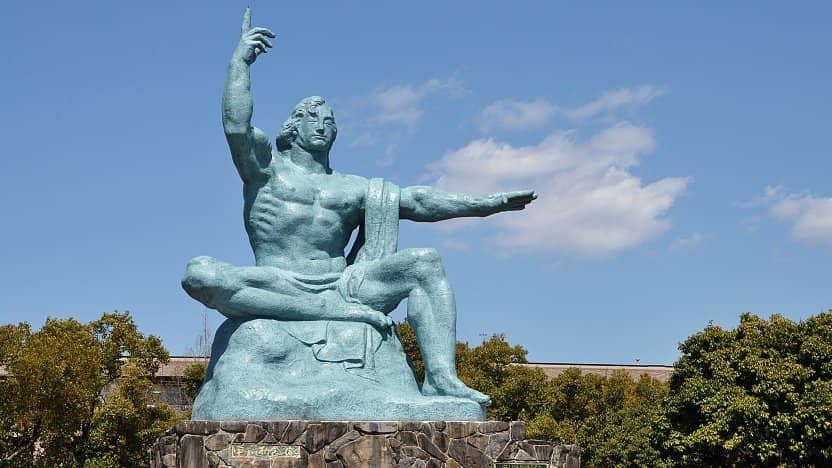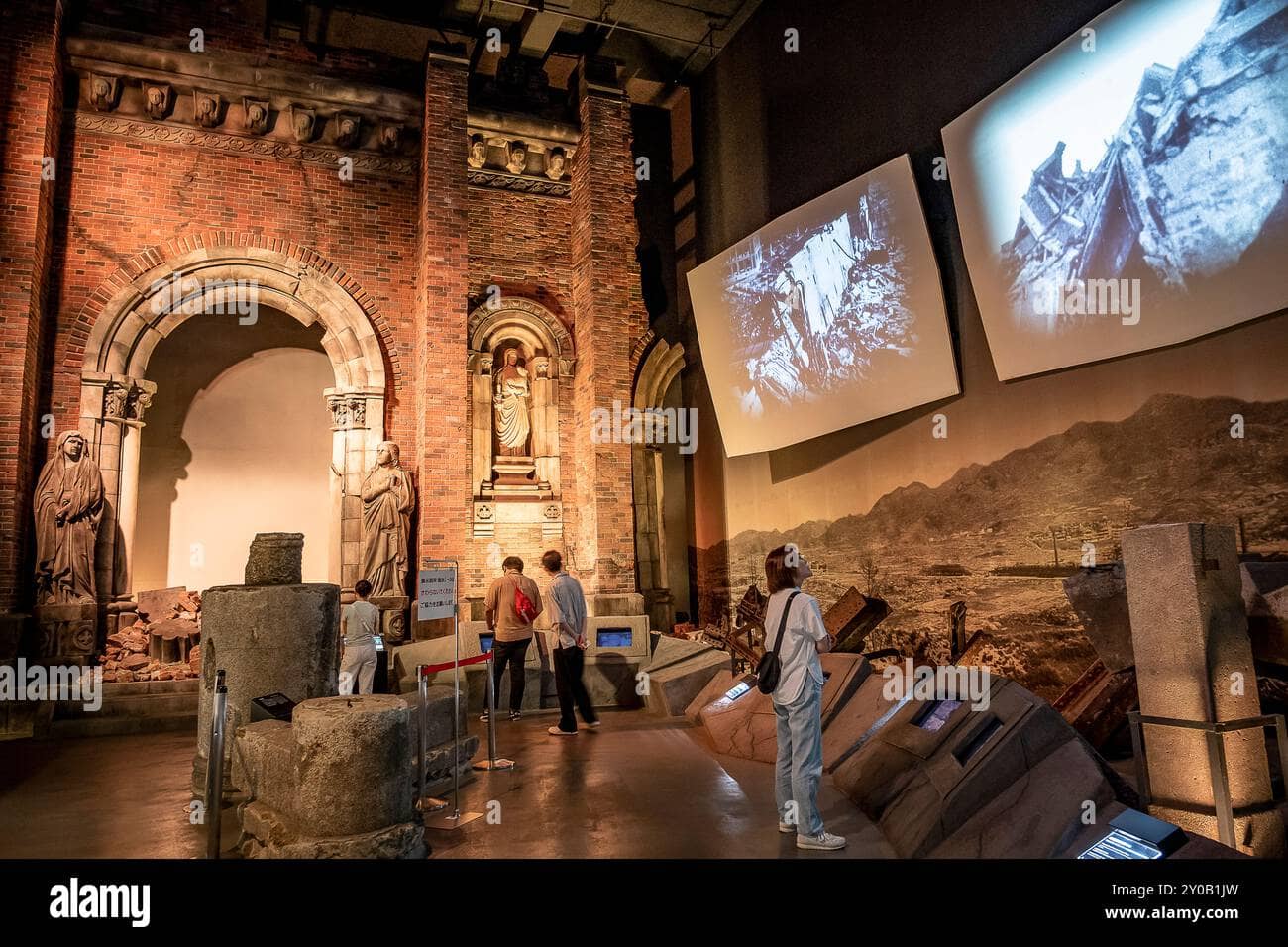Nagasaki Atomic Bomb Museum
A solemn museum preserving the memory of the 1945 atomic bombing, advocating for peace and a nuclear-free world.

Highlights
Must-see attractions

Social
From TikTok & Reddit
Best Time
Fewer crowds, more reflection
Nagasaki Atomic Bomb Museum
Best Time
Fewer crowds, more reflection

Highlights
Must-see attractions
A solemn museum preserving the memory of the 1945 atomic bombing, advocating for peace and a nuclear-free world.
"A moving and powerful experience, documenting the devastating impact of the atomic bomb with respect and emotional depth."
🎯 Use the Tram System
Trams are cheaper and quicker than buses from Nagasaki Station. :bus:
⏳ Allow Ample Time
Plan for 1-2 hours to fully absorb the exhibits and reflect. :clock:
Highlights
Discover the most iconic attractions and experiences
Survivor Testimonies
Hear firsthand accounts and see personal items of those who lived through the bombing, offering a powerful human connection to history.
Artifacts of Destruction
View stark reminders of the bombing's impact, including melted clocks and everyday objects forever marked by the blast.

Peace Park and Statue
Adjacent to the museum, this serene park features the iconic Peace Statue, a symbol of hope and a place for quiet contemplation.

Model of the Destroyed City
A detailed model vividly illustrates the scale of destruction caused by the atomic bomb, offering a sobering perspective.
Plans like a pro.
Thinks like you
Planning Your Visit
Prepare for a Solemn Experience
Getting There and Ticketing
Best Times
Insider Tips
from TikTok, Instagram & Reddit
🎯 Use the Tram System
Trams are cheaper and quicker than buses from Nagasaki Station. :bus:
⏳ Allow Ample Time
Plan for 1-2 hours to fully absorb the exhibits and reflect. :clock:
🕊️ Visit the Peace Park
Don't miss the adjacent Peace Park for quiet contemplation and to see the Peace Statue. :dove:
☕ Relax at Peace Cafe
Grab a drink and cake at the onsite cafe, a peaceful spot to process the experience. :coffee:
Tips
from all over the internet
🎯 Use the Tram System
Trams are cheaper and quicker than buses from Nagasaki Station. :bus:
⏳ Allow Ample Time
Plan for 1-2 hours to fully absorb the exhibits and reflect. :clock:
🕊️ Visit the Peace Park
Don't miss the adjacent Peace Park for quiet contemplation and to see the Peace Statue. :dove:
☕ Relax at Peace Cafe
Grab a drink and cake at the onsite cafe, a peaceful spot to process the experience. :coffee:
💰 Affordable Entry
The museum has a symbolic entry fee of 200 JPY. :moneybag:
What Travellers Say
Reviews Summary
Visitors consistently describe the Nagasaki Atomic Bomb Museum as a profoundly moving and important experience. While emotionally challenging, the museum is praised for its respectful presentation of history, its focus on peace, and its educational value. Some find the exhibits intensely somber, but most agree it's a must-visit for understanding the devastating impact of nuclear weapons.
"This is such an important preservation of knowledge and information.
It angers me beyond words of how people of today's era still believe that war brings peace! How many ppl have to die to save others? Why must so many innocent lives become play piece of the few in power?
Take the tram from Nagasaki Station , cheaper than the buses and quicker too.
Tickets at 200 ¥ per adult"
Anisah 思思
"We were here during the 80th anniversary of the dropping of the bombs. A solemn place. I sat at the column of peace and said my dad's name. He would have so appreciated the history of this sacred place. We love Japan and it's truly wonderful people."
john gayton
"It was quite a poignant visit.
As you descend the passageway towards the main exhibition halls, it seems you are moving back in time as well.
The exhibits highlight how and what the locals were doing at the moment when their lives were extinguished, or impacted, by the atomic bomb.
There are reminders of them in the stark everyday items that survive, or by their shadows forever etched into concrete by the harsh glare from the bomb. There are two old clocks that stopped at the very moment of the blast.
We spent quite a bit of time in the section that featured the memories and comments of those who initially survived the blast, and how they tried to cope with the loss of the loved ones and their homes.
Other exhibits include the development of the atomic bomb, as well as the nuclear arms race since then.
There is parking immediately at the side of the building, and you can also go up to the observation deck at the top of the garden.
There is a small cafe, appropriately called Peace Cafe, where you can grab a drink and a cake. There are many strands of origami cranes made by locals and visitors, symbolising the hope for peace."
steven lim
What People Like
What People Dislike
Frequently Asked Questions
🚇 🗺️ Getting There
The most convenient way is to take the tram from Nagasaki Station directly to the museum. Trams are generally cheaper and quicker than buses for this route. The museum is also located close to the Peace Park and the hypocenter of the bombing.
Yes, there is parking available immediately at the side of the building. It's noted as being among the cheapest parking options near the museum.
Yes, many visitors make Nagasaki a day trip from Fukuoka. The drive is considered worth it by many, and the museum is a key highlight.
While not directly at the museum, for those planning a wider trip, traveling between Nagasaki and Hiroshima is a common route. Some suggest visiting Nagasaki before Hiroshima if your itinerary allows.
While trams are recommended, local buses also serve the area around the museum. Checking local transit apps or asking at your accommodation will provide the most up-to-date bus route information.
🎫 🎫 Tickets & Entry
The museum has a very symbolic entry fee of 200 JPY per adult. This makes it an accessible and affordable experience for all visitors.
The museum is generally open daily, and visitors should allow 1-2 hours for their visit. It's always a good idea to check the official website for the most current hours, especially around holidays.
Given the symbolic entry fee and the nature of the museum, advance booking is typically not required. However, for special events or during peak travel seasons, it's wise to check their official website.
The entry fee is already very low at 200 JPY, making it highly accessible. Specific discounts for students or seniors are not widely advertised, but the low cost is a significant benefit.
Yes, audio guides are available in multiple languages, which can greatly enhance your understanding of the exhibits and the historical context.
🎫 🧭 Onsite Experience
The museum features a profound journey through history, with exhibits including photographs, survivor testimonies, artifacts, and a model of the destroyed city. It's presented with respect and emotional depth, emphasizing peace and remembrance.
Visitors typically spend about 1-2 hours at the museum to fully absorb the exhibits and reflect on the historical events. Some find it a deeply moving experience that requires time for contemplation.
The museum deals with sensitive and tragic historical events. While it's an important educational site, parents should consider the maturity of their children before visiting, as the content can be emotionally challenging.
The Peace Park is a crucial part of the Nagasaki experience, featuring the iconic Peace Statue and serving as a solemn space for remembrance and a call for world peace. Many visitors find it a necessary complement to the museum visit.
While the museum focuses on historical artifacts and testimonies, the presentation is designed to be engaging. The model of the destroyed city and the survivor accounts offer a powerful, immersive experience.
🍽️ 🍽️ Food & Dining
Yes, there is a small cafe appropriately named 'Peace Cafe' located at the museum. It's a good spot to grab a drink and a cake after your visit.
The area around the museum and Peace Park offers various dining options, including local Japanese cuisine. Chinatown is also nearby, offering Chinese food.
Generally, it's best to consume outside food and drinks before entering the museum. The Peace Cafe provides refreshments if needed.
Nagasaki, like most major Japanese cities, offers a range of dining. While specific vegetarian/vegan restaurants might require a short search, many Japanese eateries can accommodate dietary needs with advance notice.
Nagasaki is known for dishes like Champon (a hearty noodle soup) and Sara Udon (crispy noodles with toppings). These can be found in many local restaurants.
📸 📸 Photography
Photography policies can vary, but generally, flash photography is prohibited inside museums to protect exhibits. It's best to look for signage or ask staff if you are unsure about taking photos.
The exterior of the museum, the Peace Park with the Peace Statue, and the surrounding memorial sites offer poignant photographic opportunities. The exhibits inside are often too sensitive for casual photography.
Drone usage is typically restricted in public spaces and near sensitive historical sites. Always check local regulations before flying a drone.
A standard camera or smartphone is sufficient. Given the solemn nature of the site, focus on capturing the atmosphere and memorials rather than extensive detail shots inside.
Yes, photography of the Peace Statue and within the Peace Park is generally permitted and encouraged as a way to share the message of peace.
For Different Travelers
Tailored advice for your travel style
👨👩👧 Families with Kids
🚶 Solo Travelers & Reflective Visitors
📚 History Enthusiasts
Deep Dives
In-depth insights and expert knowledge
The Historical Context: August 9, 1945
The exhibits showcase the human cost of the bombing through personal belongings, photographs, and survivor testimonies. Visitors can see everyday items that were tragically altered by the blast, such as clocks frozen at the moment of impact, and learn about the 'hibakusha' – the survivors who carried the physical and emotional scars of the event for the rest of their lives. The museum also delves into the development of atomic weapons and the subsequent nuclear arms race, providing a broader historical perspective on the dangers of nuclear proliferation.
Visiting the museum is not just about remembering a tragic past; it's a powerful call for peace and a nuclear-free future. The museum's narrative emphasizes remembrance, reflection, and the hope that such devastation will never be repeated. The adjacent Peace Park, with its iconic Peace Statue, further reinforces this message, serving as a global symbol of peace.
Navigating the Museum Experience
Key exhibits include a replica of the atomic bomb itself, allowing visitors to grasp its physical scale. Photographs capture the immediate aftermath, showing the flattened landscape and the immense suffering of the survivors. Personal accounts from hibakusha are presented through written testimonies, audio recordings, and sometimes video interviews, offering deeply personal perspectives on loss and resilience. The museum also displays artifacts recovered from the blast site, such as twisted metal, charred clothing, and the poignant 'shadows' etched into stone by the intense heat and radiation.
Beyond the immediate impact, the museum addresses the long-term health effects of radiation and the global implications of nuclear weapons. The 'Peace Cafe' offers a space for quiet reflection, and the many origami cranes left by visitors symbolize a collective wish for peace. The museum's presentation is often described as respectful and informative, avoiding sensationalism while conveying the gravity of the events.
Social
from TikTok, Instagram & Reddit